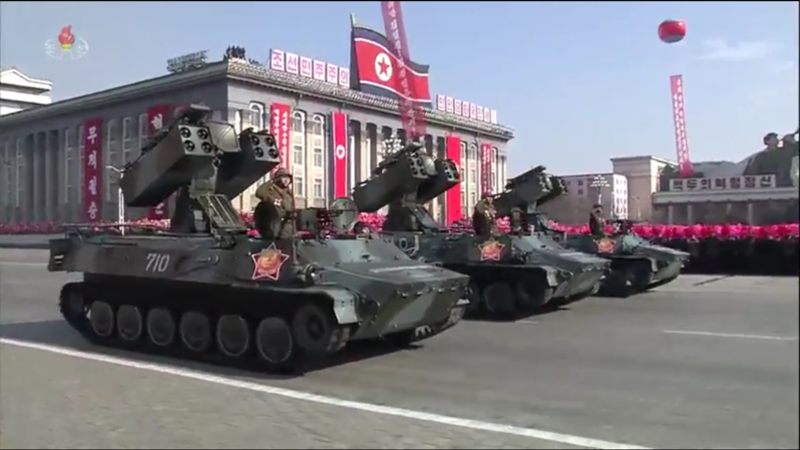North Korea unveiled its largest number of nuclear missiles in its nighttime parade this week. Pyongyang has also hinted at a new weapon in development as the isolated nation continues its nuclear program despite sanctions.
North Korean state media outlet KCNA reported on Thursday that Pyongyang showcased the nation’s weapons, the largest-ever number of intercontinental ballistic missiles along with hinting at a new solid-fuel weapon. Images released by KCNA of the nighttime parade that took place on Wednesday showed up to 11 Hwasong-17s which is North Korea’s largest ICBM and is believed to be able to strike almost anywhere in the world with a nuclear warhead.
The Hwasong-17 was first tested last year and aside from the missiles, analysts said may be a prototype of a new solid-fuel ICBM in canister launchers. North Korea has sought to develop a solid-fuel ICBM as it could make its nuclear missiles harder to spot and destroy in the event of military conflict.
The parade was in celebration of the 75th anniversary of the founding of its army, the Korean People’s Army. North Korean leader Kim Jong-un was in attendance at the parade with his daughter, who is seen as likely to take on a leadership role in the future.
The parade was criticized by the South Korean foreign ministry, saying that Pyongyang is holding such an event when it is currently facing a worsening food and economic crisis. The ministry called on Pyongyang to stop “illegal and nuclear missile development and reckless nuclear threats” and return to the negotiating table for denuclearization talks.
Early this week, Kim called for a strengthened war readiness posture and expanded military drills, during a meeting of the central military commission of the ruling Worker’s Party. KCNA reported that the officials in attendance discussed “major military and political tasks” for the year as well as the “long-term issues concerning the orientation for army building.”
“Studied and discussed there were…the issue of constantly expanding and intensifying the operation and combat drills of the KPA to cope with the prevailing situation and more strictly perfecting the preparedness for war,” said KCNA.



 Lukashenko Says Maduro Welcome in Belarus Amid Rising U.S.-Venezuela Tensions
Lukashenko Says Maduro Welcome in Belarus Amid Rising U.S.-Venezuela Tensions  Lukashenko Urges Swift Ukraine Peace Deal, Backs Trump’s Push for Rapid Resolution
Lukashenko Urges Swift Ukraine Peace Deal, Backs Trump’s Push for Rapid Resolution  Trump’s Rob Reiner Remarks Spark Bipartisan Outrage After Tragic Deaths
Trump’s Rob Reiner Remarks Spark Bipartisan Outrage After Tragic Deaths  Ukraine Claims First-Ever Underwater Drone Strike on Russian Missile Submarine
Ukraine Claims First-Ever Underwater Drone Strike on Russian Missile Submarine  Hong Kong Democratic Party Disbands After Member Vote Amid Security Crackdown
Hong Kong Democratic Party Disbands After Member Vote Amid Security Crackdown  Trump Administration Moves to Keep TransAlta Coal Plant Running Amid Rising AI Power Demand
Trump Administration Moves to Keep TransAlta Coal Plant Running Amid Rising AI Power Demand  Trump Weighs Reclassifying Marijuana as Schedule III, Potentially Transforming U.S. Cannabis Industry
Trump Weighs Reclassifying Marijuana as Schedule III, Potentially Transforming U.S. Cannabis Industry  Trump Orders Blockade of Sanctioned Oil Tankers, Raising Venezuela Tensions and Oil Prices
Trump Orders Blockade of Sanctioned Oil Tankers, Raising Venezuela Tensions and Oil Prices  NSW to Recall Parliament for Urgent Gun and Protest Law Reforms After Bondi Beach Shooting
NSW to Recall Parliament for Urgent Gun and Protest Law Reforms After Bondi Beach Shooting  Federal Judge Declines to Immediately Halt Trump’s $300 Million White House Ballroom Project
Federal Judge Declines to Immediately Halt Trump’s $300 Million White House Ballroom Project  Pakistan’s Army Chief Faces Gaza Troop Dilemma Amid US Pressure
Pakistan’s Army Chief Faces Gaza Troop Dilemma Amid US Pressure  Thousands Protest in Brazil Against Efforts to Reduce Jair Bolsonaro’s Prison Sentence
Thousands Protest in Brazil Against Efforts to Reduce Jair Bolsonaro’s Prison Sentence  Syria Arrests Five Suspects After Deadly Attack on U.S. and Syrian Troops in Palmyra
Syria Arrests Five Suspects After Deadly Attack on U.S. and Syrian Troops in Palmyra  Trump Taps Former DHS Official Troy Edgar for U.S. Ambassador Role in El Salvador
Trump Taps Former DHS Official Troy Edgar for U.S. Ambassador Role in El Salvador 































